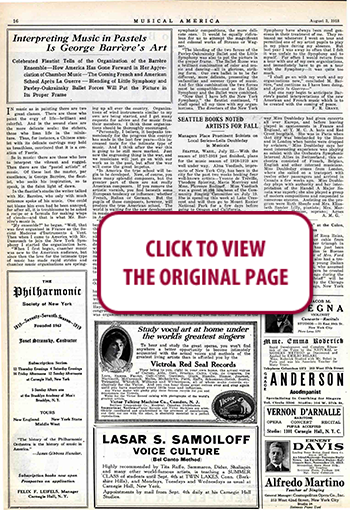 100 YEARS AGO IN MUSICAL AMERICA (252)
100 YEARS AGO IN MUSICAL AMERICA (252)
August 3, 1918
Page 16
Interpreting Music in Pastels Is George Barrère’s Art
Celebrated Flautist Tells of the Organization of the Barrère Ensemble—How America Has Gone Forward in Her Appreciation of Chamber Music—The Coming French and American School Après La Guerre—Blending of Little Symphony and Pavley-Oukrainsky Ballet Forces Will Put the Picture in Its Proper Frame
IN music as in painting there are two great classes. There are those who paint the orgy of life—brilliant and colorful. And in the second class are the more delicate souls: the etchers, those who limn life in the miniature. Thus, for instance, a Chinese amulet with its delicate carvings may hold us breathless, convinced that it is a creation of Faerie.
So in music: there are those who love to interpret the vibrant and rugged. Then there are the “pastel artists” of music. Of these last the master, par excellence, is George Barrère, the flautist, who seeks his inspiration, so to speak, in the faint light of dawn.
In the flautist’s studio the writer talked with Mr. Barrère, who only with much reticence spoke of his music. One could not blame him even had he been annoyed, for after all, it is troublesome to be asked a recipe or a formula for making wisps of clouds—and that is what Mr. Barrère’s music is.
“My ensemble?” he began. “Well, that was first organized in France as the Societé Moderne d’lnstruments á Vent. Then when I came to America with Mr. Damrosch to join the New York Symphony I started the organization here.
“When I first began, chamber music was new to the American audience, but since then the love for the intimate type of music has made rapid strides and chamber music organizations are springing up all over the country. Organizations of wind instruments similar to my own are being started, and I get many requests for advice and for music from their members. I think these organizations should be thoroughly encouraged.
“Personally, I believe, it bespeaks tremendously for the progress this country has made in the last few years—this increased taste for the intimate type of music. And I think after the war this is going to be still more marked. Just now the engrossing thing is the war, and we musicians will just go on with our work as in the past, but after the war will come the great impetus.
“In America the true school will begin to be developed. Now, of course, you have many splendid composers, but the greater part of them are not really American composers. If you remove the artistic varnish, you find beneath some European tendency or influence: whether French, Italian or German. But the pupils of these composers, however, will produce the true American school. The world is waiting for the new development in music, and I believe it shall be created in America.
“France, too; shall reap great musical benefit from the war. After the conflict there shall be a new type of music written in France—of a greater, more dignified kind. It shall probably follow Debussy. Of course, when I say follow I do not mean imitate, for imitation alone, without the science· and inspiration behind it, is never lasting. We have had many such, whose work has failed because it was merely imitative. It is like our French-fable—perhaps you have it in English about the Frog Who Wanted to Be a Bull.”
“And what of your Little Symphony and its new affiliation with the Pavley-Oukrainsky Ballet?” the writer asked.
“Well,” continued Mr. Barrère, “I have always believed that every picture must have its proper frame. Thus, one would not expect the great symphony orchestras to do those delicate works of Haydn and Mozart—it would seem incongruous. And so the Little Symphony was organized to do the more intimate symphonic compositions, the more delicate ones. It would be equally ridiculous for us to attempt the magnificent and colossal works of Strauss or Wagner.
“The blending of the two forces of the Pavley-Oukrainsky Ballet and the Little Symphony was also to put the picture in the ·proper frame. The Ballet Russe was a brilliant combination of color and music and dancing—all in glorious, striking form. Our own ballet is to be far different, more delicate, presenting the unfamiliar and serener types of music. And for this combination the two forces must be compatible—and so the Little Symphony and the Ballet were combined.
“Now that I have left the New York Symphony,” the flautist continued, “I shall spend all my time with my organizations. The directors of the New York Symphony have always been most generous in their treatment of me. They released me whenever I went on tour and permitted one of my artist pupils to play in my place during my absence. But last year I was away so often that I felt it was unfair to the Symphony and to myself. For often I would return from a tour with one of my own organizations, and immediately have to go on a tour with the Symphony—it was quite too much.
“I shall go on with my work and my organizations now,” concluded M. Barrère, “and continue as I have been doing, and Après la Guerre—”
And one may begin to anticipate Barrère’s pastel interpretations of the new American and French music which is to be created with the coming of peace. —F. R. GRANT.




 RENT A PHOTO
RENT A PHOTO





